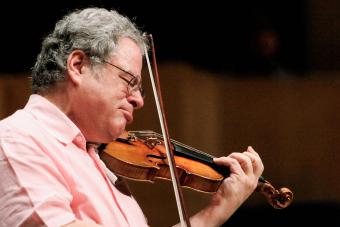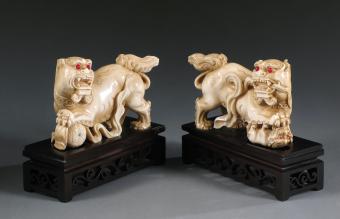
The value of antique violins is based on specific factors and the prices for authentic antiques are in the millions. Since these antiques are steadily decreasing in number on the open market, the value will only continue to appreciate. From Stradivariuses to Guareneris, all antique violins have some inherent value, and these values are based on a variety of specific criteria as well as the state of the current antiques market.
Factors That Determine Value
Antique violins have an aura of romantic mystique; however, it isn't their compelling refinement that helps them sell at market. Rather, their values are determined by a few different factors pertaining to things like their sound, what people want to buy, which luthier or manufacturer made them, and so on.
Their Sound

There are some conflicting opinions on the subject of sound, and whether the value of an antique violin is determined by the quality of its sound.
Those who argue sound has little to no effect on the price of an antique violin will state that most of the oldest, most highly valued violins in existence are rarely played, though this isn't always the case. While many collectors and museums who own a significant number of these violins are trying to preserve the violin's condition, it's true that a violin's sound is also greatly affected by the player. The human using the instrument has much more influence on how it sounds than the age or design. Even the bow will have some effect on the sound. Thus, many believe that the sound of an antique violin is completely subjective, as people perceive sound differently and the perception is often based on emotions.
While these are valid points as to why sound shouldn't have much bearing on violin values, it may also be misleading to say that it doesn't have any effect at all. Obviously, the most expensive violins are high-quality made violins. Therefore, the chance that these violins would have superior sound quality over cheaply made violins is pretty high, and fine-tuned ears should be able to hear the difference between the scales played on a $200 violin versus a $20,000 violin.
Current Market Trends
The biggest factor in determining the value of an antique violin is supply and demand. A true antique that has the documentation to prove its provenance (where it was made, when, and by whom) is a rare find. In this regard, the supply is low, and the demand is high.
There's also some speculation that prices are driven up by insider financial collaboration between sellers and the matchmakers or finders. These experts allegedly misinform unsuspecting buyers and lure them into paying exorbitant prices for violins that would otherwise have sold for less. In any case, the value of any antique always depends on what a buyer is willing to pay.
Additional Factors That Affect Antique Violin Values

Other important factors that determine value include:
- Quality of wood - Higher quality violins usually have woods that bear some flaming - aka variations in tone and color - while those of lower quality are entirely uniform in their appearance.
- Maker - With Stradivarius topping the list, the individual luthier who crafted each instrument can make or break an antique violin's value.
- Age - Violins crafted between the mid-16th and mid-18th centuries are known as the finest crafted antique violins around, and these will undoubtedly bring in the most amount of money at market.
- Appearance (unique designs, varnishes or finishes) - Markers or elements that make an antique violin unique, like a particularly intriguing carved motif or wood choice, can appeal to collectors and spur an increase in their prices.
- Condition - Things like seamless edges, inlaid purfling, and no visible cracking are all condition-based factors that can increase or decrease an antique violin's value.
Famous Violin Makers That Can Increase Value Substantially

For most, the name behind a violin's creation is one of the first things a buyer wants to know. Valuable antique violins will have makers such as these:
- Antonio Stradivari
- Giuseppe Guarneri
- Andrea Amati
- Gasparo da Salo
- Giovanni Paolo Maggini
The earliest violin makers were northern Italians Gasparo da Salo (1540-1609), Giovanni Maggini (1579-1630), and Andrea Amati (1520-1611).
Perhaps the most famous name in violin making would be that of Antonio Stradivari. Known as Stradivarius violins, his instruments are among the finest and most valuable musical instruments in the world. Antonio Stradivari was Italian, born in 1644 and living until 1737. He would inscribe his violins with Latin slogans and thus, his violins became known as the Latin equivalent of his name, Antonius Stradivarius or simply Stradivarius violins. These violins became world-famous because of the quality of their sound. The quality of the wood, the shape of the instrument, the thickness of the wooden plates placed in the belly and back of the instrument and the varnish of the wood are all believed to be important factors that contribute to this powerful, superior sound.
Giuseppe Guarneri was a renowned violin maker and contemporary of Stradivari from Cremona, Italy, who lived from 1698 to 1744. Around 1730, he made two violins from the same piece of wood. One of these violins, called the "Kreisler", was given to the Library of Congress by Fritz Kreisler in 1952. The other violin, known as the "Baron Vitta", was given to the Library of Congress in 2007 by Szymon Goldberg's wife, Miyako Yamane Goldberg, to reside with its twin.
The Costs of Buying and Selling Antique Violins
As with other concert instruments, violins have a lofty reputation for being superfluously expensive. However, the thousands of dollars that you can spend on a modern violin doesn't even mildly compare to that of an antique. When it comes to these antiques, there's a few things that're definitely sure to increase their prices. For instance, their luthier. If you can find a violin with a label connecting it to one of the great historic luthiers, then you've got a very expensive violin on your hands - no matter its condition. However, things like the presence of high-quality woods or famous luthiers shouldn't be overshadowed by characteristics that're common dog whistles in other antiques. For example, if you find an antique violin with a piece or two unattached - don't fret! It could still have substantial value, as a professional with expertise in antique violins could reattach that part with little difficulty.
Yet, you should keep in mind that these violins can range anywhere in the lower thousands to the hundreds of thousands of dollars range, and in some cases, the millions. In fact, Christie's auction house sold one Stradivarius violin named "The Solomon" for $2,728,000 in 2007. However, collectors who have that kind of cash on-hand tend to usually snatch up violins costing about $10,000-$30,000, on average. For example, these are some antique violins that've recently entered the market:
- 1825 Emanuel Adam Homolka violin - Listed for $32,917.38
- Mid-18th Century finely crafted violin by an anonymous maker - Listed for around $30,000
- 19th Century L. Hill London violin - Listed for $5,380.89
Value of an Antique Violin as an Investment
With the value of antique violins being such a subjective debate, what about investing in them?
Investing in something like rare stringed instruments requires very specialized knowledge. Even the annual average value increase for violins is a debatable subject, with estimates ranging from around 3% to 5%. Yet, it's hard to ignore these instruments' appeal when the premiere artifacts sell for millions of dollars. The highest price that a Stradivarius ever sold for at a public auction was for $3,544,000. It was nicknamed the "Hammer" and was crafted in 1707. However, this astonishing record price only applies to public auctions, and privately, Stradivarius violins have sold for much more. In fact, a quality reproduction Stradivarius can be worth between $2000 and $4000.
If you have the expertise, the passion and the capital to start investing in antique violins, they have the potential to be a secure and sound investment for years to come. With the population growing and the supply of genuine antique violins diminishing, the prices have nowhere to go except up.
Get Strung Up On These Antiques
Antique violins carry with them an enchanting quality, something that extends far beyond the music that they can produce. The lithe bodies, curled edges, and beautifully delicate forms harken back to a style of living that feels like it was plucked out of some time from the past. Yet, with their steep values and delightful sounds, you'll be incredibly lucky to own one of these legendary instruments. If you're interested in the value of other vintage instruments, learn about antique piano prices.







